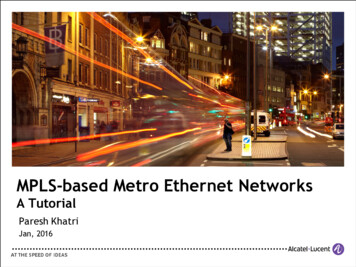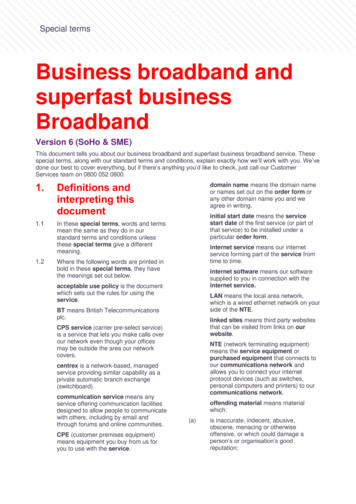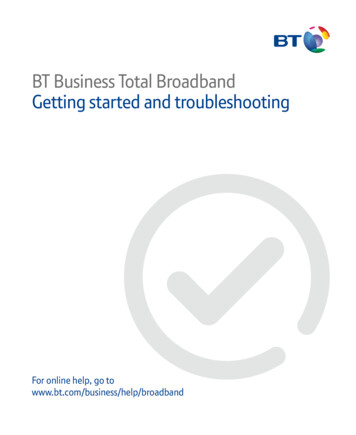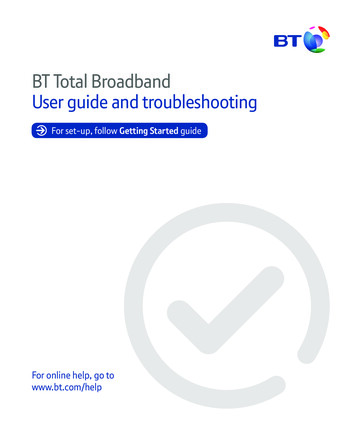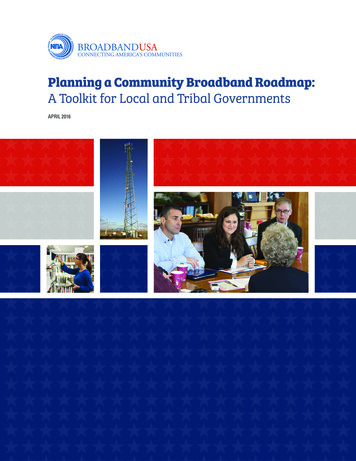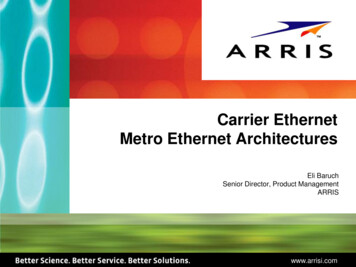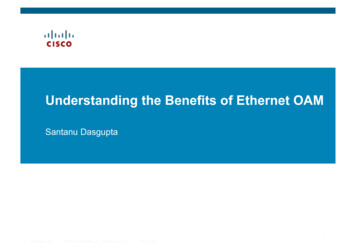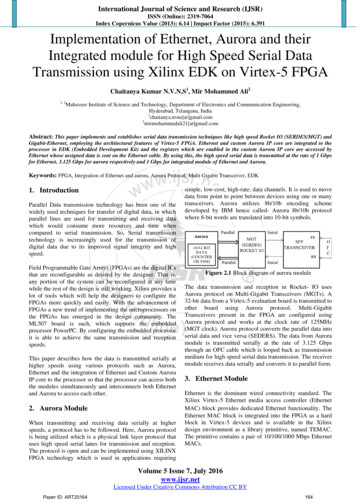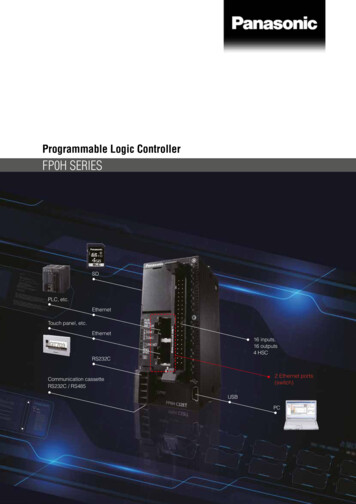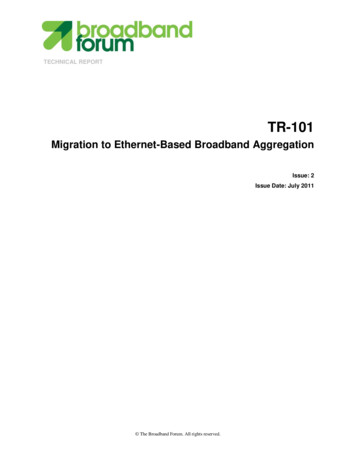
Transcription
TECHNICAL REPORTTR-101Migration to Ethernet-Based Broadband AggregationIssue: 2Issue Date: July 2011 The Broadband Forum. All rights reserved.
Migration to Ethernet-Based Broadband AggregationTR-101 Issue 2NoticeThe Broadband Forum is a non-profit corporation organized to create guidelines for broadband networksystem development and deployment. This Broadband Forum Technical Report has been approved bymembers of the Forum. This Broadband Forum Technical Report is not binding on the Broadband Forum,any of its members, or any developer or service provider. This Broadband Forum Technical Report issubject to change, but only with approval of members of the Forum. This Technical Report is copyrightedby the Broadband Forum, and all rights are reserved. Portions of this Technical Report may becopyrighted by Broadband Forum members.This Broadband Forum Technical Report is provided AS IS, WITH ALL FAULTS. ANY PERSONHOLDING A COPYRIGHT IN THIS BROADBAND FORUM TECHNICAL REPORT, OR ANY PORTIONTHEREOF, DISCLAIMS TO THE FULLEST EXTENT PERMITTED BY LAW ANY REPRESENTATIONOR WARRANTY, EXPRESS OR IMPLIED, INCLUDING, BUT NOT LIMITED TO, ANY WARRANTY:(A) OF ACCURACY, COMPLETENESS, MERCHANTABILITY, FITNESS FOR APARTICULAR PURPOSE, NON-INFRINGEMENT, OR TITLE;(B) THAT THE CONTENTS OF THIS BROADBAND FORUM TECHNICAL REPORT ARESUITABLE FOR ANY PURPOSE, EVEN IF THAT PURPOSE IS KNOWN TO THECOPYRIGHT HOLDER;(C) THAT THE IMPLEMENTATION OF THE CONTENTS OF THE TECHNICAL REPORTWILL NOT INFRINGE ANY THIRD PARTY PATENTS, COPYRIGHTS,TRADEMARKS OR OTHER RIGHTS.By using this Broadband Forum Technical Report, users acknowledge that implementation may requirelicenses to patents. The Broadband Forum encourages but does not require its members to identify suchpatents. For a list of declarations made by Broadband Forum member companies, please seehttp://www.broadband-forum.org. No assurance is given that licenses to patents necessary to implementthis Technical Report will be available for license at all or on reasonable and non-discriminatory terms.ANY PERSON HOLDING A COPYRIGHT IN THIS BROADBAND FORUM TECHNICAL REPORT, ORANY PORTION THEREOF, DISCLAIMS TO THE FULLEST EXTENT PERMITTED BY LAW (A) ANYLIABILITY (INCLUDING DIRECT, INDIRECT, SPECIAL, OR CONSEQUENTIAL DAMAGES UNDERANY LEGAL THEORY) ARISING FROM OR RELATED TO THE USE OF OR RELIANCE UPON THISTECHNICAL REPORT; AND (B) ANY OBLIGATION TO UPDATE OR CORRECT THIS TECHNICALREPORT.Broadband Forum Technical Reports may be copied, downloaded, stored on a server or otherwise redistributed in their entirety only, and may not be modified without the advance written permission of theBroadband Forum.The text of this notice must be included in all copies of this Broadband Forum Technical Report.July 2011 The Broadband Forum. All rights reserved.2 of 101
Migration to Ethernet-Based Broadband AggregationTR-101 Issue 2Issue HistoryIssueNumberIssue DateIssue EditorChanges1April 2006Amit Cohen, ECI TelecomEd Shrum, BellSouthTelecommunicationsOriginal2July 2011Tom Anschutz, AT&TAdditional access technologies,errata, minor enhancementsdeveloped in related TRs.July 2011 The Broadband Forum. All rights reserved.3 of 101
Migration to Ethernet-Based Broadband AggregationTR-101 Issue 2Comments or questions about this Broadband Forum Technical Report should be directed toinfo@broadband-forum.org.EditorTom AnschutzEnd to End Architecture David AllanDavid ThorneWG ChairsAT&TEricssonBTVice ChairSven OogheAlcatel-LucentChief EditorMichael HanrahanHuawei TechnologiesJuly 2011 The Broadband Forum. All rights reserved.4 of 101
Migration to Ethernet-Based Broadband AggregationTR-101 Issue 2Table of Contents1.INTRODUCTION AND PURPOSE . 111.1Document Scope . 111.2ATM Based Architectures . 111.3Broadband Network Gateway Assumptions . 131.4Motivation for Migration to Ethernet Based Broadband Aggregation . 131.5Requirements . 141.6Key Terminology . 141.7Acronyms . 202.FUNDAMENTAL ARCHITECTURAL AND TOPOLOGICAL ASPECTS . 222.1Residential Gateway . 232.2The U Interface . 232.3Access Node . 242.4Access Node Deployment Options . 252.5The V interface . 272.5.1VLAN Architectures . 282.6Ethernet Aggregation Network . 322.7Broadband Network Gateways . 332.8Multicast Architecture . 342.9QoS support . 342.10 Business Services Support . 362.11 Policy Management . 363.ACCESS NODE REQUIREMENTS . 373.1VLANs . 373.1.1VLAN ID and Priority Assignment Capabilities . 373.1.2VLAN Allocation Paradigms . 413.2Access Node Forwarding Mechanisms . 413.2.1General . 413.2.2Forwarding in N:1 VLANs . 413.2.3Forwarding in 1:1 VLANs . 423.3QoS . 423.3.1Traffic Classification and Class of Service Based Forwarding . 433.4Multicast Support . 443.5Protocol Adaptation Functions . 443.5.1PPPoE over ATM (U-interface) . 443.5.2IPoE over ATM (U-interface) . 453.5.3IP over ATM (U-interface) . 463.5.4PPP over ATM (U-interface). 473.6Multi-session Support . 513.7L2 Security Considerations . 513.7.1Broadcast Handling . 513.7.2MAC Address Spoofing . 513.7.3MAC Address Flooding . 523.7.4Filtering . 523.8Additional IWF for IPoE based Access in N:1 VLANs . 533.8.1Layer 2 DHCP Relay Agent . 533.8.2DHCP Processing . 543.8.3ARP Processing and IP Spoofing Prevention . 553.9Access Loop Identification and Characterization . 553.9.1DHCP Relay Agent . 56July 2011 The Broadband Forum. All rights reserved.5 of 101
Migration to Ethernet-Based Broadband AggregationTR-101 Issue 23.9.2PPPoE Intermediate Agent . 563.9.3Access Loop Identification Configuration and Syntax . 583.9.4Access Loop Characteristics . 603.9.5Signaling the Access Loop Encapsulation . 623.9.6BNG to RADIUS Signaling of Broadband Line Characteristics . 633.10 OAM . 654.ETHERNET AGGREGATION NODE REQUIREMENTS. 664.1VLAN Support . 664.2QoS . 664.3Multicast . 664.4Forwarding Information and Loop Detection (Spanning Tree) . 664.5OAM . 675.BROADBAND NETWORK GATEWAY REQUIREMENTS . 685.1VLAN Support . 685.2QoS – Hierarchical Scheduling . 685.2.1Policing . 695.3Multicast . 695.4ARP Processing . 705.5DHCP Relay . 705.6OAM . 705.7Security Functions . 705.7.1Source IP Spoofing . 706.MULTICAST . 726.1Methodology . 726.2Baseline Multicast Description . 726.2.1RG Requirements . 746.2.2Access Node Requirements . 746.2.3Aggregation Node Requirements . 776.2.4BNG Requirements . 786.3Specific Broadband Considerations . 786.3.1Goals . 786.3.2Single Node Deployments . 806.3.3Dual Node Deployments . 826.3.4Proxy Reporting Support . 837.OAM . 847.1Ethernet OAM . 847.2Ethernet OAM Model for Broadband Access . 857.3Ethernet OAM Requirements . 877.3.1RG Requirements . 877.3.2Access Node Requirements . 887.3.3Aggregation Node Requirements . 917.3.4BNG requirements . 927.4Interworking between Ethernet and ATM OAM . 948.NETWORK MANAGEMENT . 968.1Access Node Requirements . 968.2BNG Requirements. 96APPENDIX A - PPPOE VENDOR-SPECIFIC BBF TAGS . 978.3PPPoE Tag - Circuit ID and Remote ID. 988.4PPPoE Tag - Broadband Line characteristics . 98July 2011 The Broadband Forum. All rights reserved.6 of 101
Migration to Ethernet-Based Broadband AggregationTR-101 Issue 2APPENDIX B - DHCP VENDOR SPECIFIC OPTIONS TO SUPPORT ACCESS LINECHARACTERISTICS . 100July 2011 The Broadband Forum. All rights reserved.7 of 101
Migration to Ethernet-Based Broadband AggregationTR-101 Issue 2Table of FiguresFigure 1 – TR-025 High Level Architectural Reference Model . 12Figure 2 – TR-059 High Level Architectural Reference Model . 12Figure 3 – Network architecture for Ethernet-based Broadband aggregation . 22Figure 4 – Protocol stacks at the U interface . 24Figure 5 – ATM to Ethernet inter-working function . 24Figure 6 – Access Node deployment scenarios. 27Figure 7 – Protocol stacks at the V interface . 28Figure 8 – VLAN assignment in multi-VC architecture . 30Figure 9 – VLAN assignment in untagged/priority-tagged architecture . 31Figure 10 – VLAN assignment on tagged UNI . 32Figure 11 – Example aggregation architecture options . 33Figure 12 – Example distributed precedence and scheduling model with dual nodes . 35Figure 13 – Example Scheduler . 43Figure 14 – End-to-end protocol processing for PPPoE access. 45Figure 15 – End-to-end protocol processing for IPoE access . 45Figure 16 – End-to-end protocol processing for IPoA access . 46Figure 17 – End-to-end protocol processing for PPPoA access. 48Figure 18 – State transition diagram for PPPoA IWF . 49Figure 19 – Example message flow with PPPoA IWF . 50Figure 20 – PPPoE access loop identification tag syntax . 58Figure 21 – Multicast Reference Model . 72Figure 22 – Multicast deployment decision tree . 80Figure 23 – Example of Ethernet OAM maintenance domains in a Broadband network . 84Figure 24 – Ethernet OAM model for broadband access . 86Figure 25 – Ethernet OAM model for broadband access – wholesale “Ethernet bit-stream” services model . 86Figure 26 – The Ethernet and non-Ethernet flow within the AN . 89Figure 27 – Communication channel between BNG & AN . 95July 2011 The Broadband Forum. All rights reserved.8 of 101
Migration to Ethernet-Based Broadband AggregationTR-101 Issue 2Table of TablesTable 1 – Default and/or configurable filtering behavior of reserved group MAC destination addresses . 53Table 2 – Circuit ID Syntax . 60Table 3 – Access loop characteristics sub-options . 61Table 4 – TLVs for New Broadband Forum RADIUS VSAs. . 64Table 5 – Mapping new Broadband Forum RADIUS VSAs to RADIUS message types . 65July 2011 The Broadband Forum. All rights reserved.9 of 101
Migration to Ethernet-Based Broadband AggregationTR-101 Issue 2Executive SummaryThis Technical Report outlines how an ATM aggregation network can be migrated to an Ethernet basedaggregation network in the context of TR-25 and TR-59 based architectures. TR-101 provides anarchitectural/topological model of such an Ethernet based aggregation network that supports the businessrequirements in TR-058. In doing so it describes requirements for protocol translation and interworking,QoS, multicast, security, and OAM for a Broadband aggregation network. The architecture defined in TR101 remains popular today for service providers with limited needs to support multiple service types on asingle access. Therefore this revision was undertaken to bring the work “up to date” with respect to newaccess technologies it can support as well as to address a number of errata and minor improvements.July 2011 The Broadband Forum. All rights reserved.10 of 101
Migration to Ethernet-Based Broadband AggregationTR-101 Issue 21. Introduction and Purpose1.1Document ScopeTR-101 outlines how an ATM aggregation network can be migrated to an Ethernet based aggregationnetwork in the context of TR-25 and TR-59 based architectures. TR-101 provides anarchitectural/topological model of such an Ethernet based aggregation network that supports the businessrequirements in TR-058. In doing so it describes requirements for protocol translation and interworking,QoS, multicast, security, and OAM for a Broadband aggregation network.TR-058 describes the marketing requirements for a multi-service architecture. These requirementsinclude the following capabilities: Improved transport (the main focus of this document) Many-to-many access (multi-session) Differentiated services (including QoS and QoS on Demand) Bandwidth services (including Bandwidth on Demand) Content distribution (including multicast capabilities) Simpler provisioning Support for business services (e.g. Layer 2 VPN, high availability, higher bit rate services)TR-101 does not provide details/requirements with respect to scale and performance of individualelements, but does focus on documenting a functional architecture and the requirements necessary tosupport it. Also note that TR-101 builds on the requirements defined in TR-092, Broadband RemoteAccess Server (BRAS), and TR-124, Functional Requirements for Broadband Residential GatewayDevices, as components of the architecture. This revision does not address multi-service businessrequirements defined in TR-144 nor its related architectures. Neither does this Technical Report provideguidance on the use of, or transition to, using IPv6. Those aspects are defined in TR-177 and in workunder development within the Broadband Forum.1.2ATM Based ArchitecturesDSL deployments in the past have followed the architectural guidelines of TR-025 or the more advancedTR-059 (reference models are depicted in Figure 1 and Figure 2 respectively). Both architectures usedATM to aggregate the access networks into the regional broadband network. In such deployments theAccess Node functions as an ATM aggregator and cross-connect, multiplexing user ATM PVCs from theU interface onto the V interface and de-multiplexing them back on the opposite direction (see Figure 1).July 2011 The Broadband Forum. All rights reserved.11 of 101
Migration to Ethernet-Based Broadband AggregationTR-101 Issue rPremisesFigure 1 – TR-025 High Level Architectural Reference ModelLegacyATM NSPATMATMA10-NSPNSP1L2TPL2TSA10-NSPUser1NSP2IP - QoSIPBRASAccessNode(DSLAM)ATMA10-NSPMDF LocalLoopNIDCPETASP1User2VIP - QoSCustomer Prem. NetA10-ASPRegional BroadbandNetworkAccess NetworkUFigure 2 – TR-059 High Level Architectural Reference ModelThe traffic aggregated from the Access Nodes is steered to an IP node, the BRAS. In TR-025 a BRAScould be physically located either in the regional network or in the service provider network and is mainlyengaged in PPP termination and tunneling. In TR-059 the BRAS is located on the edge of the regionalnetwork and its functionality is enhanced to include subscriber management, advanced IP processing,including IP QoS, and enhanced traffic management capabilities, e.g. 5-layer hierarchical shaping.TR-101 was originally released in 2006. It specified a new architecture based on Ethernet aggregationinstead of ATM. TR-101 has been extremely well adopted. However, since the release of TR-101,several technologies have emerged that can be used instead of DSL in the Access with few or even noarchitectural changes. Further, DSL itself has undergone some updates and improvements. The TR-101architecture remains desirable for service providers that are interested in triple-play capabilities, but maynot wish to move to the more general multi-service architecture based on TR-144 and on work underdevelopment within the Broadband Forum. Significant interest, therefore, exists in re-issuing TR-101.This revision retains the business drivers and basic architecture of the original TR-101, but includes newtechnologies, and makes some clarifications and modifications based on the industries‟ experience withTR-101 over the past few years. The opportunity has also been taken to do a general update with regardto language, state of the industry, etc.July 2011 The Broadband Forum. All rights reserved.12 of 101
Migration to Ethernet-Based Broadband AggregationTR-101 Issue 2So as not to confuse the use of the term BRAS, this document has adopted the term Broadband NetworkGateway (BNG). A Broadband Network Gateway may encompass what is typically referred to as a BRAS(as specified in TR-092), but this is not a requirement of this architecture (see the following Section 1.3).For the purpose of clarity in this document we define the term ‘aggregation network’ as the part of thenetwork connecting the Access Nodes to the Broadband Network Gateway (i.e. this is the edge of theregional network according to TR-025 and part of the access network according to TR-059). In bothTR-025 and TR-059 the aggregation network is ATM based.TR-101 defines a new access network topology where the connectivity between the Access Node and theBroadband Network Gateway is Ethernet based rather than ATM. Access nodes can be directlyconnected or go through an aggregation layer(s) before reaching the Broadband Network Gateway.1.3Broadband Network Gateway AssumptionsTR-059 based architectures assume a single Broadband Remote Access Server (e.g. BRAS) where userservices are performed.TR-101, however, recognizes the potential for service segregation. Some applications, such as video,may have specific enough requirements from the network that they are best optimized separately fromother types of traffic.The architecture described in this document supports the possibility for a dual Broadband NetworkGateway (BNG) scenario when required for video optimization. When used, the BNG dedicated to videois denoted as the „video BNG‟. Such an approach may have additional complexities not present with asingle BRAS/Broadband Network Gateway arrangement described in TR-059. This is most notable withrespect to traffic/bandwidth management and the resulting network efficiency as well as the additionaloperations overhead.Furthermore, in dual node architectures, it is not mandated that both BNGs support all of therequirements detailed in this document. Specifically, the video BNG may not implement subscribermanagement functions (e.g. PPP termination, per user QoS) given that these functions are likely to beperformed by the other BNG.A multi-node deployment (more than 2) could follow the same recommendations described within thisdocument, but will not be explicitly described here; this is the subject of TR-144 and of work underdevelopment within the Broadband Forum.1.4Motivation for Migration to Ethernet Based Broadband AggregationAccess architectures are evolving from ADSL(1) based networks to a much wider range of accesstechnologies including multiple types of xDSL (e,g, ADSL2 , VDSL, G.SHDSL), optical access (e.g. PONand point-to-point fiber) and even wireless (e.g. 3G, WiMAX and LTE
The Broadband Forum is a non-profit corporation organized to create guidelines for broadband network system development and deployment. This Broadband Forum Technical Report has been approved by
